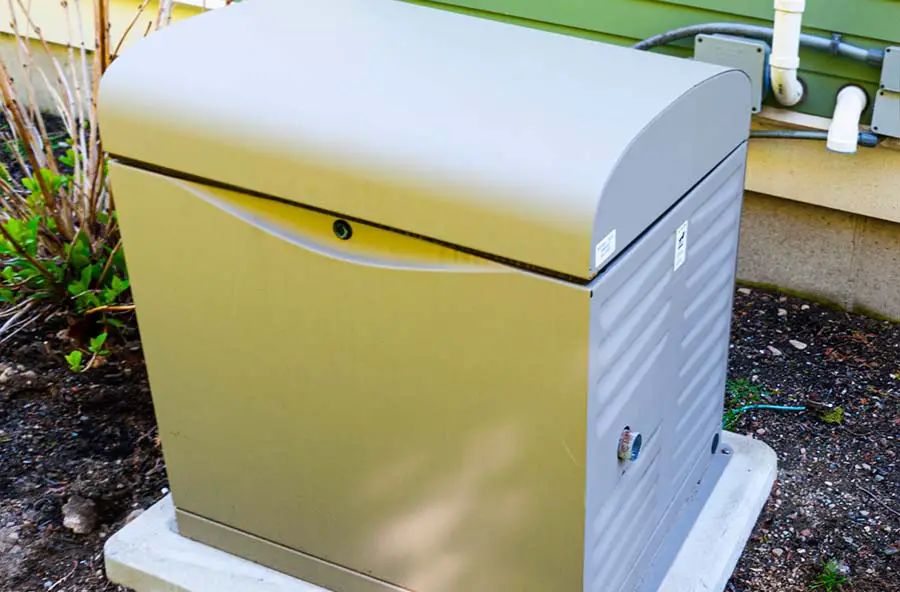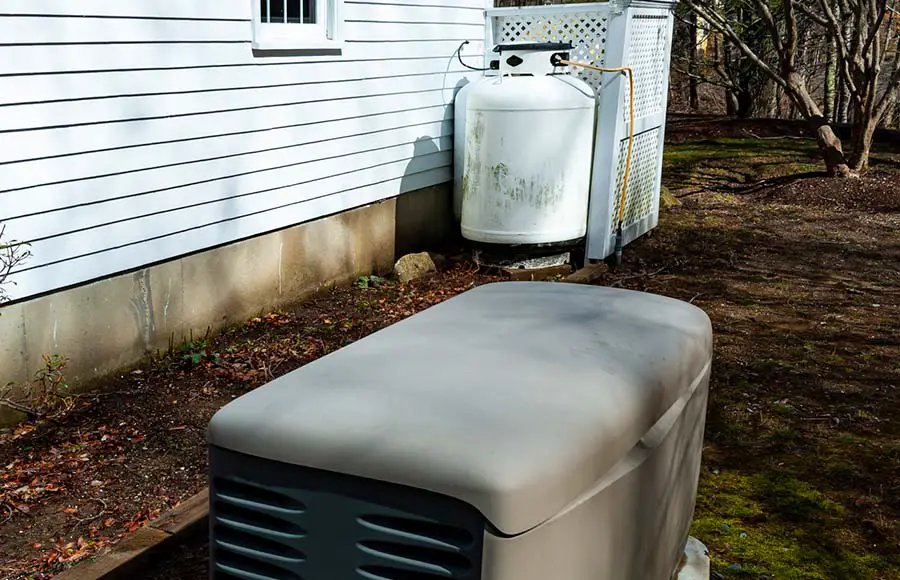
While a whole house generator provides many advantages during emergencies, it can also pose harm if not placed at a safe distance. Generator exhaust contains carbon monoxide, so you must keep them outdoors. But how far should your whole house generator be from the house?
Whole house generators should be a minimum of 1.5 feet (18 inches) away from the house and at least 5 feet (60 inches) away from any windows or doors. If possible, generators at least 20 feet from the house are best. The final distance depends on local building codes, noise, and safety requirements.
This article will discuss the dangers that whole-home generators pose that make it necessary to observe the safety distances. In addition, it will include all the relevant factors to consider when installing your whole house generator.
How Far Away From a House to Install a Whole House Generator
There are many more considerations beyond the bare minimum distances when choosing how far away from the house you should install a whole house generator. Here are a few of the things to consider when deciding on a location and distance for your generator:
- The manufacturer’s requirements
- The size of your generator
- Your lot size
- The position of your home and its relevant features
- Local noise ordinances
- Applicable air quality regulations
- The position of your utility lines
- Storage tank requirements
- Method of connection
- Local building codes
- The desired generator enclosure systems
Let’s take a closer look at each of these to help you make the best decision for your situation.
1. The Manufacturer’s Requirements
Your whole house generator may come with specific instructions on installing it. If that is the case, it would be wise to consider them when positioning your power-generating equipment.
These guidelines may include the minimum distances from your home’s rear end, the base upon which you should place the generator, and so on. Failure to adhere to the manufacturer’s instructions may void your generator’s warranty or your homeowners’ insurance coverage.
2. The Size of Your Generator
How big your whole house generator is will determine how much noise it produces, the size of the fuel storage tank it may require, and the kind of support system it will need to stand on one spot. And all these things will end up determining how far you place your generator.
Also, you have to think about the size of the enclosure you would need for your standby generator and whether you can accommodate it within your property. Generally, the bigger and heavier your standby generator is, the larger and thicker the concrete base it needs to support its weight.
The general rule of thumb is a concrete pad’s depth should be 125 percent of the unit wet weight, which considers both the generator and fuel.
For example, a 12,000 lbs. generator would require 15,000 lbs. of concrete for support. And since concrete weighs an average of 150 pounds per cubic foot, you can use that and the size of the generator to determine the depth of the base. Afterward, you can select the best position for that amount of concrete within your property since not all soil types can accommodate so much weight.
3. Your Lot Size

The size of your property also affects your standby generator’s final resting place.
You need to keep your neighbors safe from the dangers that your standby generator poses. So, the equipment should be at least five feet from any lot line. And that’s where the generators are allowed within the side, front, or rear setback areas. These vary depending on your local laws and the zoning district.
Therefore, you should ensure that wherever you place the generator, you observe the required distance from all your lot lines regardless of the direction.
4. The Position of Your Home and Its Relevant Features
There are many guidelines concerning positioning a standby generator relative to a home and its relevant features.
For instance, according to the National Fire Protection Association (NFPA) code, a standby generator should have a minimum distance of 18 inches from the existing wall of your home. But that rule assumes there are no openings along that wall.
Also, many other regulators tend to recommend a distance of at least 20 feet from your home for extra safety, with the exhaust facing away from it. In that case, you should ensure your standby generator maintains that distance not just from your home but also all your neighbors’ homes.
If you place a generator along a wall with windows, doors, vents, or any other openings, it must be at least 5 feet away from them at all angles. And that distance also applies to any combustible wall.
Also, there should be at least 36 inches of clearance between the generator and any nearby vegetation.
But it is also worth noting that the 5-foot minimum limit applies to both the exhaust outlet side and weatherproof enclosure in general. And it also affects the generator’s distance from any vegetation over 12 inches tall. At the very least, clearing from the top should be 48 inches at a minimum.
However, the set distance is at least five feet or 60 inches from any overhanging vegetation or structure in many cases.
In addition, standard guidelines prevent homeowners from setting the standby generator enclosure under any structure that confines the airflow, which would increase the likelihood of carbon monoxide poisoning.
5. Local Noise Ordinances
Since generators can significantly contribute to noise pollution, you must consider any local noise ordinances. Also, consider your Homeowners’ Association (HOA) rules on acceptable noise levels.
The area you live in will determine the community noise ordinances. What is acceptable in one place will be unacceptable in another. So, do your research and find what noise regulations apply in your locale. And if you cannot install a generator to decrease noise levels effectively, consider quieting its sound.
For example, according to the New Jersey Noise Control Council, generators should produce 65dB of noise or less during daytime and 50dB of noise or less during nighttime. And this distance is based on the generator being at least 23 feet away from any home. Failure to adhere to these noise ordinances may result in fines of $2,000 to $3,000 per day!
6. Applicable Air Quality Regulations
We have already established that generators contribute to air pollution. For that reason, it would be best if you considered the air quality regulations governing generators in your area to avoid trouble.
Standby generators usually need a permit. And you will only get that permit if you prove that you have observed all the air quality regulations. The rules governing carbon monoxide poisoning are one of them. They usually affect how far a generator can be from your openings.
7. The Position of Your Utility Lines
Where your buried utility lines are located can make or break the final resting place of your whole-home generator. Those lines don’t belong to you. So, you have to jump through the hoops to get permission to reroute them or run new lines if you need to install a generator.
Your first order of business should be to find out where your local utility lines are. You can do that by contacting your area’s 811 offices in advance. And then, a utility locator will eventually come to locate, identify, and mark the existing utility lines.
Based on the available information, you can determine where to place your generator, so it does not interfere with them or pose a danger to everyone nearby.
Another benefit of learning the current position of your utility lines is that you can position your generator to tap into natural gas if available. That would ensure a continuous fuel source even in extreme weather situations.
8. Storage Tank Requirements

If you intend to use natural gas to fuel your standby generator, you need to prioritize the existing utility line positions during your consideration process. But other fuel sources will require a storage tank. And that comes with its own set of challenges.
Typically, storage tanks come in various volumes and weight capacities. Larger tanks can hold more fuel, but they also require more space, whether above or belowground. And they must be an appropriate distance away from your home and generator to prevent fires and explosions.
For example, depending on the tank size, propane tanks should be a minimum of anywhere from 3-25 feet away from a building’s openings, ignition source, and property line. Usually, larger tanks will need to be farther away from each other, your generator, and your home.
Rules also apply for underground tanks. And these determine how deep you can excavate to accommodate the fuel tank. In addition, the location of the safety valves will determine the position of the fuel storage tank and, thus, the generator.
9. Method of Connection
You can connect a standby generator to your home via a transfer switch or extension cables. Automatic transfer switches are usually the best option because they eliminate the need for too many wires. And they make it easier for you to place the generator closer to your home if property size is an issue because it connects to your existing circuit breaker panel.
On the other hand, extension cables present many challenges. For example, to safeguard against fires arising from the use of incorrect and overloaded cords, you have to position them and the generator correctly. That way, the cables would be away from flammable materials, not melt or overheat, and avoid causing fires.
However, suppose you have heavy-duty cords and live in a large property. In that case, you can place the generator very far away from your home to minimize noise and air pollution using extra-long extension cables. That said, you won’t be able to power hardwired appliances such as a furnace using this option. So, do remember that.
10. Local Building Codes
Your local building codes may set different standards for installing a whole-home generator than the manufacturers and minimum standard requirements. These codes may consider the local soils, climate, and residential needs. For that reason, it would be best to learn what your construction regulators say.
For example, in the state of New York, if your generator or its enclosure consists of fireproof material, you can install a generator a distance of 18 inches from your home’s exterior.
However, you must maintain a clearance of at least five feet from combustible walls or material of your standby generator. Also, you will need to install the generator to meet the manufacturer’s specifications.
11. The Desired Generator Enclosure Systems
A whole house generator requires protection from the elements because it will stay in one spot for prolonged periods. But the enclosure you construct may be subject to its own set of industry and local rules and regulations that, in turn, will affect where you install the whole-home generator.
Generally, you should build a generator housing structure at least five feet away from a building’s openings, vegetation, and combustible materials.
However, if the adjacent wall or any other structure has a fire rating of one hour or more, and the generator consists of a non-combustible enclosure system, you don’t have to observe this rule. Also, all the penetrations within the generator housing structure should contain materials that can withstand the heat produced by the machine.
It is also worth noting that housing structures vary regarding their purpose. Some protect the generator from the weather, while others help reduce noise levels. In addition, some enclosures will reduce the likelihood of fires, and others will do all these things simultaneously.
Consider the safety of your generator, fuel tank, and utility lines as well. If you live in an area where vandalism is rife, your generator structure should withstand thieves and vandals. That may mean putting it closer to your home together with the generator.
Dangers Associated with Whole House Generators
There is no doubt that standby generators are necessary for any homeowner looking to run their appliances when the primary power supply goes off. However, these pieces of equipment are not 100 percent safe. For that reason, it would be best to learn the dangers they pose to safeguard yourself, your loved ones, and your neighbors.
1. Carbon Monoxide Poisoning
Carbon monoxide poisoning occurs when people inhale odorless and colorless carbon monoxide gas for prolonged periods. It usually occurs in poorly ventilated spaces where propane, diesel, or gasoline engines run. Symptoms include:
- Dizziness
- Weakness
- Headache
- Loss of consciousness
- Confusion
- Death
Each year, around 50,000 people require medical treatment due to accidental carbon monoxide poisoning. And about 430 of them will die from it. You may not realize that portable generators significantly contribute to these numbers. Eighty-five percent of all carbon monoxide fatalities are from generators.
Since whole house generators contain an internal combustion engine that burns fuel partially, they also produce carbon monoxide. Therefore, you need to be careful regarding where the whole-home generator’s exhaust system faces.
If it is too close to your home, you will be in danger. But if it is too close to your neighbor’s property, they will be in trouble, thanks to you. But because they usually remain outdoors, they pose less danger than portable versions.
2. Air Pollution
Air pollution is another issue to worry about when considering installing a whole house generator. It causes damage to the environment by increasing emissions and health problems within the human population.
Typically, diesel and gasoline generators create more pollution than their propane and natural gas counterparts, which is critical to keep in mind.
3. Noise Pollution
Many types of generators are synonymous with noise. Unfortunately, prolonged noise exposure is harmful to your health. Research shows that people who experience excessive noise levels of over 70dB for extended periods may end up with a hearing loss in the future. And anything above 120dB can damage your hearing instantaneously.
Generally, a silent generator will make 75-85dB of noise from a distance of one meter. But most will produce 60-70dB of noise from about 23 feet away, which is tolerable and pretty safe, even for prolonged periods.
Therefore, it would be best to think about your hearing and how noise pollution from a standby generator would affect that when considering how far to install it.
4. Electrocution
Generators produce electricity. Under the right circumstances, they can shock and electrocute you.
If you expose your generator to water, you will likely get electrocuted. While pure water is not a good conductor of electricity, most water from the elements is not pure. As a result, it will facilitate shocking and electrocution. It would be best to avoid any wet area when installing a generator.
Another source of electrocution comes from the overlapping of the whole-home generator and the primary power source. If your generator is on when the primary power source comes back, it can cause back-feeding.
During this process, the electrical flow will be forced to go in the reverse direction, thus re-energizing the power lines far away from your home. Utility employees or anyone else handling the lines could get electrocuted when that happens. Also, your neighbors who share the same transformer could fall victim.
5. Explosion and Fires
Whole house generators may end up causing fires and explosions due to various reasons, so you should select the best position for installation.
For starters, overloading a generator can cause an explosion and fires. Also, if you used the wrong cables to connect your standby generator to the existing electrical system, they could overheat and start a fire. If there is something flammable in the vicinity, the fire could spread quickly, and you could lose your home.
Also, generator parts tend to be pretty hot when the equipment is in use and just after you have switched it off. So, they could cause severe burns if you come into contact with them.
Fuel is also a matter of concern. If you store fuel near flammable materials or next to the generator or any other fuel-burning device, it can increase the rate at which the fire spreads. In addition, if you use excess fuel in your generator, it could explode, start a fire, and cause severe damage.
Final Thoughts
If you have not bought a whole house generator yet, it would be best to wait. First, consider the dangers these engines cause, factors affecting the ideal position, and select a place to install it to ensure the highest safety standards possible. And then, you can choose the best generator for your needs and install it with minimal hassles.
When in doubt, always consult the professionals. You would rather spend money on the planning than have to deal with the consequences of not doing so later. Breaking the rules could cost you money in fines, destroy your entire property, and render you homeless.
